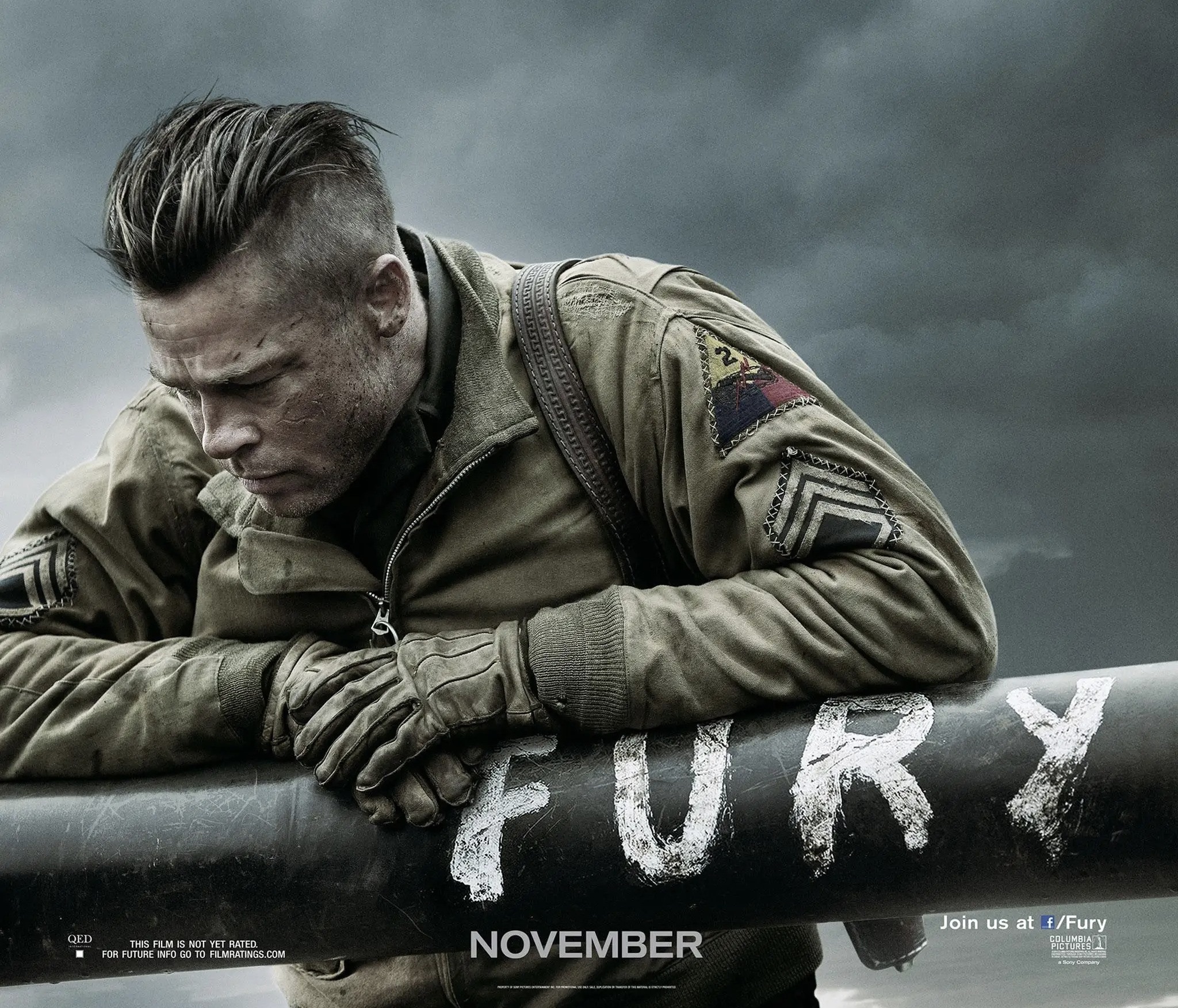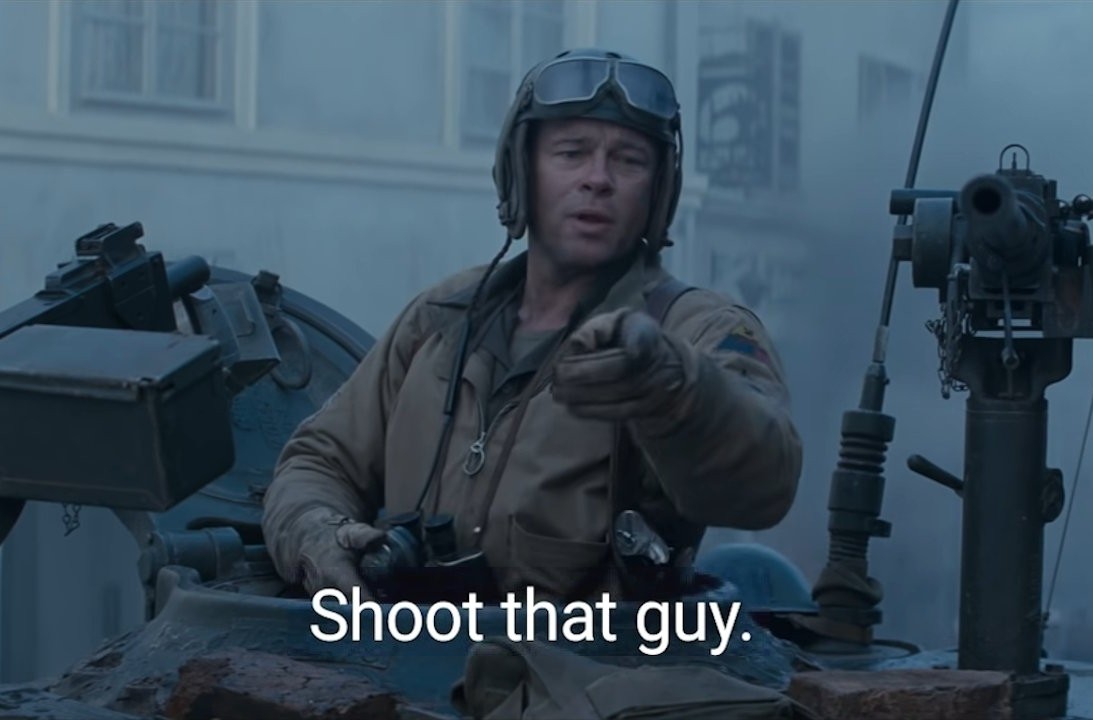Brad Pitt – The Berserker Wardaddy
In the final episode of 'wardaddies' we look at Brad Pitt as Staff Sergeant don 'Wardaddy' Collier in David Ayer's 2014 film Fury.

David Ayer has written some fairly solid crime dramas (Training Day, 2001, End of Watch, 2012), directed one very violent superhero movie (Suicide Squad, 2016), some dopey action movies (Sabotage, 2014, The Beekeeper, 2024) and one godawful urban fantasy film (Bright, 2017*). Prior to Fury, Ayer’s one foray into WWII was his screenplay for Jonathan Mostow’s submarine thriller U-571 (2000) – a film which turned out to be so historically inaccurate that it briefly set back Anglo-U.S. relations.
Ayer’s screenplay retold the story of the capture of a German U-boat in the Atlantic along with its precious ‘Enigma’ cipher machine. The problem was that Ayer’s version of this incident switched the identity of the Allied sailors from British to American – prompting U.K. Prime Minister Tony Blair to declare that the film was an ‘affront’ to the memories of the British sailors who lost their lives on that actual mission.
A few years later, in an interview with the BBC, Ayer issued a mea culpa – admitting that changing the nationality of the Allied crew was:
“…a distortion…a mercenary decision…to create this parallel history in order to drive the film for an American audience. Both my grandparents were officers in the Second World War, and I would be personally offended if somebody distorted their achievements.”
Fury was released in 2014 and it stars a 50 year old Brad Pitt in an absolutely joyless performance as a veteran tank commander who can’t decide whether he wants to shepherd his crew through the final days of the war or go out in a blaze of glory.
Playing opposite him is former child star Logan Lehrman who does a great job of portraying the hapless Private Norman Ellison – a military clerk who suddenly finds himself stuck in the footwell of a big filthy tractor with only a machine gun for company.
Jon Bernthal gives another of his patented Big Dumb Arsehole performances alongside Michael Pena while Shia LaBeouf brings a bit of manic intensity to his devoutly-religious-tank-gunner character**.
According to the Motion Picture Association Ayer interviewed four veterans from the 2nd Armored Division during pre-production; George Smilanich, Ray Stewart, Don Evans and Paul Andert. Ostensibly veterans are employed by productions like Fury as ‘historical consultants’ to share their first-hand experience ansd fact check the sceenplay. In reality veterans are mainly there for PR purposes – to provide audiences with the illusion that the film they’re watching has received a stamp of approval from those who were actually there.
I very much doubt the four men in question were given an opportunity to moderate Ayer’s violent fantasies but, at the very least, he could have used their biographies to add a bit of authenticity in terms of casting. Smilanich was drafted at the age of 20, Stewart was drafted at 19, Evans enlisted at 18, and Andert falsified his age to sign up at age 17.
Journalists and film critics rarely get back in contact with these veterans to find out what they make of the finished product but, to their credit, The New York Times did get in touch with Don Evans to see what he thought of Fury. He was clearly hesitant to give a full endorsement of Ayer’s film – pointing out that the film featured several scenes of combat that were more extreme than anything he experienced in his 28 months spent on the front lines. Along similar lines one British tanker who’d fought in WWII offered his verdict in the Guardian.
“I thought the film showed accurately how tough life could be in a tank, but the final scene where the crew hold out against a battalion of Waffen SS troops was too far fetched. The Germans seemed to be used as canon fodder. In reality they would have been battle-hardened and fanatical troops who would have easily taken out an immobile Sherman tank using Panzerfausts (an anti-tank bazooka). They also seemed to have an inexhaustible supply of ammunition and fuel. A Sherman tank only does five miles to the gallon so I think they would have run out long before the final showdowns”
As mentioned in the video – the best part of Fury takes place between the action sequences when Wardaddy and Ellison force their way into the home of German civilians Irma (Anamaria Marinca) and her teenage daughter, Emma (Alicia von Rittberg) who reluctantly offer their hospitality. After tense introductions Ellison pairs off with Emma and the two have a roll in the hay before the rest of the crew turn up and make things uncomfortable. As written, Ellison’s condensed courtship of Emma is entirely wholesome but we’d probably need to see a Rashomon-style version of that interaction from her perspective to gauge the actual level of coercion involved. Hats off to Ayer for even suggesting that U.S. GIs took advantage of the civilian population.
As far as I can tell Fury’s only enduring contribution to popular culture is a brief scene where Pitt’s character casually orders the execution of an SS trooper who is vainly attempting to surrender. An image of Pitt with the caption ‘shoot that guy’ has become a favourite response among edgy keyboard warriors when they encounter opinions they don’t like.

My verdict:
Two stars. One for all the real tanks and one for all the very realistic filth. Kudos to the women in wardrobe who frayed all the canvas webbing and scuffed up all the forage caps. You did a wonderful job. I only wish that it was in the service of a better film.
*Admittedly I’ve never actually seen Bright but I got the gist from a wonderfully exasperated review by media critic Lindsay Elllis.
**Clearly Shia LaBeouf thought this film was going to make more of a cultural impact than it did because he took the drastic step of cutting open his cheek with a knife and having one of his teeth removed to ‘get into character’. Rumour has it he also refused to shower while making the film – a decision that probably didn’t endear him to his co-stars. As Lawrence Olivia said when faced with another die-hard Stanislavskian; “Why don’t you try acting, dear boy? – It’s much easier.”
The Real ‘Wardaddy’
In Fury Brad Pitt’s character is inspired by a real U.S. tank commander by the name of Lafayette ‘Wardaddy’ Pool. He and his crew are credited with destroying a dozen German tanks and more than 200 other vehicles alongside an unknown number of German troops. He’s sometimes referred to as a ‘Tank Ace’ but, from what I understand, the armoured corps didn’t really approve of that sort of oneupmanship so ‘ace’ is more of an informal designation. Pool was, however, awarded a number of medals and commendations for his aggressive tactics.
In terms of behaviour Pool doesn’t seem to have resembled the rabid Staff Sergeant played by Pitt in David Ayer’s film but his actual personality is pretty hard to pin down. He certainly must have possessed a pretty fierce competitive streak because in 1944 he tried to win an exhibition match put on to entertain the troops against heavyweight champion Joe Lewis. According to those who served with him, he was either a mild-mannered comrade they trusted implicitly or a ruthless cowboy they feared more than the enemy.
Cpl Wilbert ‘Baby’ Richards had this to say about his Sergeant when interviewed for Yank magazine in 1945.
“He hated Germans, and he thought that he could lick ’em all. The guys used to draw straws to see who’d lead the spearhead. Pool would have none of that. He’d just say, ‘Ah’m leadin’ this time,’ in his old Texas drawl – and stand there, grinning, while we cussed him out…He rode that tank like a Texas bronc. Well, he used to sit up there and give us orders through the intercom phone just as cool and calm as though the big show were a maneuver. All Pool wanted was to get out ahead of the other tanks so he could kill some more jerries”.
70 years later, after the cussing had been forgotten, Stephen Moore interviewed Bertrand ‘Schoolboy’ Close who gave a much more benign description of their commander.
“Close was careful around his older and more experienced tank mates. They kidded with one another but never took advantage of one another’s good nature. “We knew the boundaries,” he said. “We didn’t swear at each other or use foul language. We respected each other’s limited right to privacy to read and write letters.” But they shared good news. Pool and gunner Oller were always thrilled to receive letters from their wives with the latest news on how their young sons were doing. “We shared our extra rations and our boxes from home,” said Close. “I gave my cigarettes to whomever was out.”
You can get a slightly different take on Lafe Pool from a 1951 film called Here Come the Tanks* directed by Lewis Seiler. That film was written by WWII infantry veteran Sam Fuller – although it’s not one of his best screenplays and, judging by its complete absence from Fuller’s biography, not one he was particularly proud of. In terms of its tone Here Come the Tanks is disturbingly upbeat given the subject matter – not quite Hogan’s Heroes but a world away from Fuller’s other films like The Steel Helmet and Fixed Bayonets! (which were released in the same year). The tagline chosen by Warner Bros was ‘The Happy, Scrappy Story of Uncle Sam’s Iron-Nerved Yanks in Tanks!’
Here Come the Tanks provides an episodic account of the 3rd Armored Division’s push trough Germany’s Siegfried Line in Late 1944 and it stars Steve Cochran as Staff Sergeant Francis ‘Sully’ Sullivan – a cocky and somewhat heartless sergeant who whips his platoon into shape following the death of their first commander. Pool is not mentioned by name but the events and the characterisation were enough to spur Pool to sue Warner Bros for infringing on his right to profit from his own life story (which he’d sold to Universal Studios). The lawsuit was unsuccessful.
*The film was also released under the equally awkward title The Tanks Are Coming – which is not be confused with a 1941 educational short also titled The Tanks Are Coming. Confused enough?
Notes:
Christopher Miskinon (2020) – American Tank Ace Lafayette Pool
Stephen Moore (2022) – Blood and Fury
Bryan Abrams (2014) – World War II Veterans Helped Fuel Fury‘s Realism
Michael Smith (2014) – WWII Hero Advises Brad Pitt
Michael Cieply (2014) – ‘Fury,’ Starring Brad Pitt, a Raw Look at Warfare
Leave a Reply